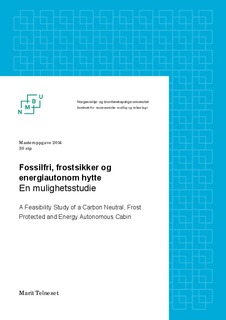| dc.description.abstract | The state-owned enterprise, Statskog SF, is the largest landowner in Norway. Currently, Statskog owns a property lacking the infrastructure for water and electricity in Sør-Trøndelag County, Norway. In this area, Statskog plans to develop a small community of environmental friendly cabins that are sustained by renewable energy technologies. This thesis investigated the possibilities of energy generation from solar cell (Photovoltaics), wind turbine and thermoelectric generator for teh proposed development, Nognillosen. Also. estimates were made for the amount of electricity needed to power the cabin, depending upon the diverse energy consumption of cabin users. During periods of low temperatures, freezing problems may occur when water is stored inside the cabin. Therefore, a low-energy solution to protect the cabins from frost was also presented. The goal was to explore an autonomous solution in each cabin in contrast to looking at a common solution for the whole community.
The energy consumption for high demand users at a cabin was estimated to be 19 kWh during a week. For lower demands, the energy consumption is estimated to be 6 kWh for the same period of time.
A common demand of a cabin users is to have easy-access throughout the year, without being concerned that the water is frozen. It has been evaluated that off-grid cabins cannot be frost protected by electric power. As a solution, this thesis proposed using geothermal energy to collect heat by water and circulating the water through pipes inside the walls of an insulated room. To keep the temperature at 5 \textcelsius\ inside the room, the required water flow was calculated to be 0,88 l/min. Due to natural convection the low water flow will provide an automatic circulation in the water well. A pump should be used to start the circulation in the well, and was calculated to have minimum consumption of 2,29 mW. To pump water through pipes inside the walls of the room, a minimum of 5,56 mW would be required.
In order to calculate power generation from solar cells and wind turbines at Nognillosen, solar radiation data was extracted from PVGIS and wind measurements is provided by Kjeller Vindteknikk. Solar radiation on a horizontal surface at Nognillosen is measured to 890 kWh/m${^2}$ for a whole year. It was suggested to place solar modules with 90\textdegree\ declination angle on the south-end wall of the cabin for optimal power generation during winter. This would decrease the power loss from snow accumulation on the modules. The power production was calculated to be 385,5 kWh for a whole year with 690 Wp solar modules. Average wind velocity at Nognillosen in 2013 was 5,28 m/s in a height of ten meters above the ground. During April, a 500 W wind turbine is calculated to generate 251 kWh of energy.
A thermoelectric generator uses heat from a heated source to generate electricity. By placing it on a wood stove, a small but steady power production could be provided, irrelevant of climatic conditions. Because of high power consumption during winter, a thermoelectric generator was determined as an asset to wind and solar generation.
Lead-acid batteries were suggested as an energy storage because of high capacity and low cost. To keep the storage autonomous for a week, it was estimated that seven batteries for high-energy consumption and three for low-energy consumption.
In the light of the solutions mentioned, the thesis presents the possibilities for an off-grid cabin to be self-sustaining, and have low-carbon footprint, at the same time. Furthermore, it shows a solution of frost protection that will provide high comfort and low maintenance. | nb_NO |

